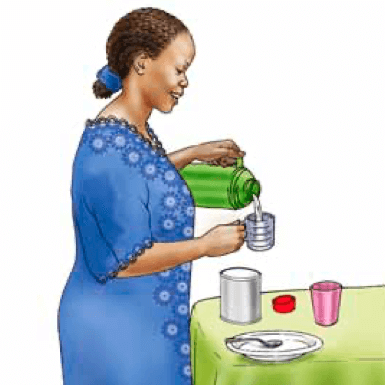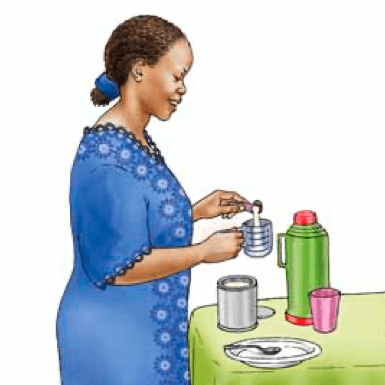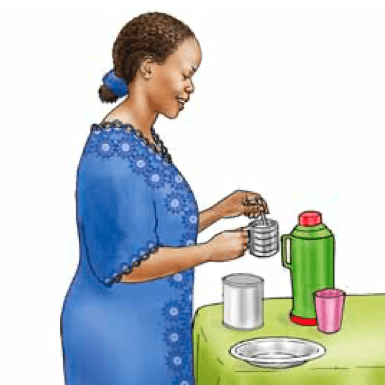When to Use Commercial Infant Formula
- Mother is unable to breastfeed or express breast milk
- Infant has difficulty feeding directly from the breast or cup
How to Prepare Commercial Infant Formula
You need
- Clean and sterilized infant bottle or cup
- Powdered infant formula
- Measurement scoop (9 grams)
- Clean, safe water
Follow these steps
- Wash your hands with soap and water.
-
Using a clean cup, scoop clean water and pour into a sterilized infant bottle or cup.
 Source: UNICEF- Infant and Young Child Feeding Counseling Cards for Community Workers.
Source: UNICEF- Infant and Young Child Feeding Counseling Cards for Community Workers. -
Add corresponding amount of formula.
 Source: UNICEF- Infant and Young Child Feeding Counseling Cards for Community Workers.
Source: UNICEF- Infant and Young Child Feeding Counseling Cards for Community Workers. -
Secure nipple, ring and cap to bottle. If using cup, use a clean spoon to stir content.
 Source: UNICEF- Infant and Young Child Feeding Counseling Cards for Community Workers.
Source: UNICEF- Infant and Young Child Feeding Counseling Cards for Community Workers. - Shake bottle or stir content in cup until formula and water are well-mixed.
- Use immediately.
How to Store Commercial Infant Formula
Tightly cover store commercial infant formula canisters and store in a dry and clean space. Prepared infant formula can be stored safely in clean containers for up to the following times:
| Kitchen counter | Refrigerator | Freezer |
|---|---|---|
| 2 hours | 24 hours | Not recommended |
Recommended Amounts of Commercial Infant Formula
Feed infants based on their cues for when and how much to feed. The following table shows general recommendations by age on formula amount and number and frequency of feeds.
| Age (months) | Formula Feedings (times per day) | Formula per Feeding (ml) | Total Daily Formula (ml) | Complementary Foods (times per day) |
|---|---|---|---|---|
| 0-1 | 6-10 | 60-120 | 550-700 | -- |
| 1-2 | 6-10 | 60-120 | 650-850 | -- |
| 2-3 | 6-10 | 60-120 | 700-950 | -- |
| 4-6 | 6-7 | 150-180 | 750-1350 | -- |
| 6-8 | 4-5 | 150-180 | 700-950 | 2-3 |
| 9-12 | 3-5 | 150-180 | 500-950 | 3-5 |
